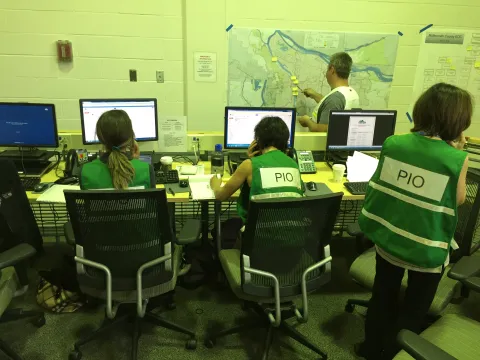Command Staff - Leadership for the event

The Command Staff includes the EOC Manager and/or Unified Commanders, the Liaison Officer, the Safety Officer, and Public Information. Scroll down to read about each role.
EOC Manager and/or Unified Commanders
Basic description: Sets the objectives, and has overall responsibility in the EOC. Because all emergencies and disasters have disproportionate impacts, Multnomah County has a goal of always having someone from our Equity Leadership as one of our Unified Commanders.
An EOC Manager and/or Unified Commanders make decisions within a high-risk, uncertain environment. This position has good communications with superiors, the public, and with the response organization. Major skills and attributes include:
- Assessing and bringing clarity to a chaotic situation.
- Setting goals and objectives.
- Forming an effective, efficient, and appropriate ICS organization.
- Communicating using risk communication strategies and techniques.
Public Information

Basic description: Provides accurate, coordinated, timely and accessible information to affected audiences, including governments; media; the private sector; and the local populace, including children, individuals with disabilities and/or access and functional needs, and individuals with limited English proficiency. Serves as the conduit for information to internal and external stakeholders, including the media. Creates information that can be transmitted to members of the general public and responders who are located in or near affected areas in multiple and accessible formats and languages in a culturally and linguistically appropriate manner that is understandable to all appropriate populations, such as individuals with access and functional needs; those with limited English proficiency; pediatric populations; populations with disabilities and others with access and functional needs; the aging; and those with temporary or chronic medical conditions.
The Public Information Officer (PIO) creates and works with a public information system that meets communication objectives. Major skills and attributes include:
- Processing and simplifying information describing the situation.
- Identifying who needs to know as well as the effective and efficient channels to reach them (a staff role of Community Connectors).
- Learning and addressing public perceptions and fears.
- Organizing and leading a staff of suitably skilled and talented communicators.
Liaison
Basic description: The primary contact for supporting organizations that are assisting at the time of the incident (where the organizations are not part of the ICS structure).
The Liaison Officer (LO) has relationships with Agency Representatives of organizations that are assisting and cooperating with the response organization. The LO brings concerns to the EOC Manager and has good interpersonal and communication skills. Major attributes include:
- Knowledge of and good relations with assisting/cooperating organizations and stakeholders.
- Good communication and collaboration between assisting/cooperating organizations and the leaders in the response organization.
Safety
Basic Description: The primary responsibilities of the Safety Officer are to ensure responders and the public are properly safeguarded from the hazards of the incident and supervise and execute all safety functions in support of the incident.
The Safety Officer (SO) establishes protocols to ensure workforce safety, investigates accidents, and stops unsafe activities. Responsibilities include:
- Monitors and assesses safety hazards
- Develops measures for ensuring personnel safety
- Inspects facilities for safety hazards
- Participates in developing the Incident Action Plan (IAP) regarding safety implications
- Provides safety briefings and distributes safety messages
- Monitors incident operations and advises the Incident Commander (IC) or center director on all matters relating to the health and safety of emergency response personnel
- Stops and prevents unsafe actions during incident operations
Next Steps...
If this or any of the other positions below spark your interest or you’d like to find out more, please fill out our Emergency Operations Center online interest form and we will contact you.
In addition, the following introductory level courses are recommended for all disaster response staff:
- ICS 100: Introduction to the Incident Command System. This is an interactive web based course.
- ICS 700: An Introduction to the National Incident Management System. This is an interactive web based course.
- Deployment - Assignment Basics. This is a County-led training opportunity. Registration for County staff is through Workday.
